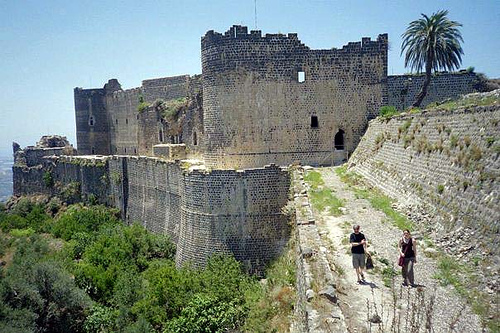

Margat Castle is a medieval stronghold near a town of Baniyas in Tartus Governorate of Syria. It was constructed in 1062 by the Muslims to prevent attack from the Western European and Byzantine threat. Margat Castle was one of the largest citadels of the Knights Hospitallers in the Holy Land.
Location: Baniyas, Tartus Governorate Map
Constructed: 1062
Margat is located near the Mediterranean coast, about six kilometers south of Baniyas on a 280 meter high folded hill of volcanic origin. In this area, the foothills of Jebel Ansariye come within two kilometers of the coast.
Margat Castle is located at a point where the Djebel al Ansariye
mountain range almost reaches the coast. It controlled the coastal road
from Tartus to Latakia and guarded the flank of the Principality of
Antioch to the County of Tripoli. The Assassins' Muslim enclave was
nearby.
The first castle was built in 1062 by a local landlord.
In 1104 the Byzantine admiral Kantakuzenos conquered it during a
military expedition. In 1116, the then lord of the castle, Ibn Muhriz,
handed the castle over to Prince Roger of Antioch in exchange. Renaud
Masoier, an important partisan of the prince, received the castle as a
fief. He began to build a massive castle on the basalt mountain. From
1133 to 1140, the complex temporarily fell back into Muslim hands during
the conflicts between the Crusader states of Antioch and Tripoli. In
1140, Renaud II Masoier (Baron Reinald Mansoer II) was able to regain
possession of it. In 1157, 1170 and 1186 the castle suffered extensive
damage from earthquakes. Although Renaud II had large estates, the costs
of maintaining the castle and its crew exceeded his financial resources.
He had to sell his property piece by piece to the Order of St. John.
After his death in 1185, his son Bertrand finally sold the castle to the
Order of St. John on February 1, 1186 for an annual pension of 2,000
gold Byzantines.
The Order, at the height of its power, quickly
restored the castle to defensive status. After the Battle of Hattin,
when Sultan Saladin passed directly by the castle, he did not attack it.
The mighty fortress, which has survived to this day, was built in the
years up to around 1205. It was considered the headquarters of the Order
of St. John and was the starting point for many military operations at
the beginning of the 13th century. She was able to repel attacks from
her opponents. Around 1205 a general chapter of the order was held at
the castle.
By the middle of the 13th century the situation had
changed. The Crusader states were increasingly unable to cope with the
military pressure of the Mamluk Sultan Baibars. Ever larger parts of the
territory fell into Mamluk hands. In 1269 and 1270, two sieges by
Baibar's troops were repelled. In 1281, the Mamluk leader Balban al
Tabbakhi was commissioned to conquer Margat. The army, which numbered
7,000 men, was once again turned away.
On April 17, 1285, Sultan
Qalawun, Baibar's successor, appeared again in front of Margat with a
Mamluk army. The fortress withstood bombardment from throwing machines
for five weeks. The undermining of the walls and towers ultimately
caused the defenders to surrender after the collapse of the so-called
spur, the southern outwork of the keep, on May 23, 1285. According to
tradition, Qalawun showed the Johanniters the already completed mining
tunnels and thus convinced them of the pointlessness of further defense.
After the conquest, the damage caused by the siege was quickly
repaired. Due to its strategic location, the fortress remained one of
the most important installations in the country in both Mamluk and
Ottoman times. There was a small Turkish garrison here until the 20th
century.
The word 'Marqab' is derived from Arabic. Root رقب (Raqaba) and means something like 'watch' or 'guard'.